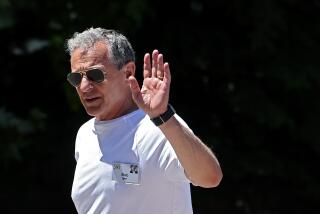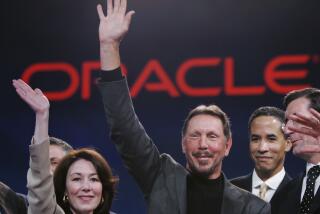Eisner May Drop Chairman Post but Continue as Chief Executive
PHILADELPHIA — The City of Brotherly Love became the venue for a nephew’s scorn as Walt Disney Co. insiders said Tuesday that Michael Eisner may step down as chairman of the board but remain chief executive.
The company’s expected move to split the two jobs -- an abrupt reversal of position -- comes as Eisner faces a bitterly contested shareholder vote on his reelection to the board of directors. The campaign against Eisner is being led by former director Roy E. Disney, the nephew of company founder Walt Disney.
Although running unopposed, Eisner could be wounded if a substantial percentage of shareholders, perhaps 30% or more, withhold votes from him.
Sources close to the board said former U.S. Sen. George Mitchell, now Disney’s presiding director, would be the leading candidate to replace Eisner as chairman.
The election tally is set to be announced toward the end of Disney’s much-anticipated annual meeting here today. The board is then expected to convene later in the day to discuss Eisner’s future -- though it may not take immediate action.
Word of the board’s plan to sever the chairman and chief executive positions was immediately condemned by Eisner’s critics, who say he should also be ousted as CEO. They accuse him of tarnishing Disney’s finances and image through poor management of such assets as the ABC television network and the once-powerhouse animation unit.
Roy Disney and fellow former director Stanley P. Gold spent much of Tuesday debunking the plan to split Eisner’s titles as “spinning” by the company -- an eleventh-hour attempt to grapple with the growing challenge to Eisner’s leadership. The two men, who are championing the opposition movement, accuse the board of trying to shift the debate from Eisner’s failures to his job title.
“We need to find him a new job in a galaxy far, far away,” Roy Disney said. Other powerful shareholders, including the California Public Employees Retirement System, agree that nothing less than Eisner’s exit is needed to fix the company.
Seven blocks from Independence Hall, about 1,500 shareholders waited throughout the afternoon in a block-long line to hear Gold and Disney compare their efforts to the city’s earlier quest for liberty.
“After all, what we are involved with here is a fight for our rights, the fight against the tyranny of a dysfunctional management and an ineffective board,” Gold said.
At the same time across the street, Disney President Bob Iger fired back during a brief press conference.
“Over the past few months, a campaign of disinformation and distortion has been waged against us,” Iger said. “Tomorrow at our shareholders meeting we are going to set the record straight.”
Disney executives say Eisner and his team have turned the company around, with strong growth predicted for the next three years.
The crowd of dissidents that showed up Tuesday to hear Gold and Disney remained unpersuaded.
Freelance animator Bill Moore of New York hoisted a sign with a picture of Michael Eisner as Frankenstein and the words “Dump Mike” as he waited to get inside Loews Philadelphia Hotel. There, two ballrooms overflowed with shareholders in what resembled a revival meeting for the Disney of old.
Orange and purple goodie bags containing blue “SaveDisney.com” T-shirts, notepads and “Goodbye Michael” bumper stickers were handed out by workers in red T-shirts.
A giant screen flashed inspirational quotes from Walt Disney and a series of historic clips. Roy Disney, wearing a Mickey Mouse tie, was greeted with a standing ovation.
Earlier in the day, Gold and Disney met with more than 150 members of the media, vowing that regardless of the outcome, their campaign would remain alive until Eisner’s departure.
“We’re not going away until Mr. Eisner’s gone,” Gold said.
Their criticisms ranged from the mundane (not replacing lightbulbs and cleaning bathrooms at the theme parks) to the specific (earnings are no better than they were in 1998) to the philosophical (“The company doesn’t know who it is,” Roy Disney said).
Three Disney public relations executives attended the dissidents’ meeting -- and were escorted from the ballroom.
Roy Disney and Gold also said that an unsolicited takeover bid by Philadelphia-based cable operator Comcast Corp., while too low to be acceptable, shows how vulnerable Disney has become under Eisner. Disney’s board has rejected the offer.
In his press conference across the street at the Convention Center, Iger, surrounded by life-size statutes of Mickey Mouse in various costumes, said the criticisms were baseless.
He noted that Disney’s stock price was up 60% in the last year and that the company was poised to see a 30% increase in earnings per share in 2004. He noted a recovery is underway at Disney’s theme parks and consumer products unit, while its studio continues to prosper.
“We have fantastic creativity,” Iger said. “That is the result of great management.”
Disney shares eased 11 cents to $26.76 on the New York Stock Exchange. They have been trading in a narrow range for the last week, with investors awaiting the annual meeting.
*
(Begin Text of Infobox)
The story line
A look at some key points during Michael Eisner’s reign at Walt Disney Co.:
1984: Michael Eisner is recruited by Roy E. Disney to become chief executive and chairman.
1980s: Disney limits availability of its classic films on videocassette to help keep the brand fresh.
1987: First Disney Store opens.
1989: Disney revitalizes the animated film market with “The Little Mermaid,” which sets box-office records.
1991: Disney quarterly profit declines for the first time since 1984. The company signs a distribution deal with Pixar Animation Studios. Disney releases the box-office hit “Beauty and the Beast.”
1992: Euro Disney opens with great fanfare but is soon struggling with poor attendance.
1993: Disney buys independent movie powerhouse Miramax Films. The company posts its first quarterly loss in nine years, brought on by Euro Disney.
1994:
* Disney releases “The Lion King,” which becomes the biggest animated movie of its time and spawns major initiatives in toy licensing, video sales and even a Broadway stage show.
* Disney President Frank G. Wells dies in a helicopter crash in April. Eisner undergoes quadruple heart bypass surgery in July.
* Disney studio chief Jeffrey Katzenberg resigns, setting off a contentious battle over his severance package.
* Disney drops a bid to buy NBC after being offered only a minority stake.
1995:
* Controversy erupts when various church groups and religious organizations protest the Miramax-produced “Priest,” a film about a homosexual cleric.
* Disney announces a plan to purchase Capital Cities/ABC for $19 billion.
* “Toy Story,” the first film resulting from the Disney-Pixar deal, opens and is a phenomenal success.
1996: Disney fires President Michael Ovitz, who is awarded a severance package then worth more than $100 million.
1997: Disney signs a new five-picture deal with Pixar.
1998: The Disney-Pixar “A Bug’s Life” breaks box-office records.
1999: ABC scores big with “Who Wants to Be a Millionaire.” Disney and Pixar release another hit, “Toy Story 2.”
2000: The company says it will close at least 100 Disney Store outlets.
2001:
* Disney incurs a charge of more than $800 million to shut its Web portal Go.com.
* Disney buys Fox Family Worldwide from News Corp. for $5.2 billion.
* Disney’s California Adventure theme park opens in Anaheim to disappointing crowds.
* “Monsters, Inc.,” another Disney-Pixar product, takes in $530 million in worldwide box-office receipts.
2002:
* ABC’s prime-time audience declines 24%, one of the steepest year-to-year plunges in network history.
* “Treasure Planet” premieres with one of the weakest openings ever for a Disney animated film.
2003:
* Dissident board member Andrea L. Van de Kamp quits, saying she was forced out by Eisner, an allegation Disney denies.
* Disney sells its Anaheim Angels baseball team for $180 million.
* The company puts its Disney Store outlets up for sale.
* The latest Disney-Pixar release, “Finding Nemo,” becomes the highest-grossing animated film of all time.
* Roy Disney resigns as vice chairman and begins a bid to oust Eisner. Roy Disney’s board ally, Stanley P. Gold, resigns a day later in support.
2004:
* Jan. 30: Pixar announces an end to its successful partnership with Disney after protracted talks to renew their contract collapse.
* Feb. 11: Cable operator Comcast Corp. launches an unsolicited bid to buy Disney in a deal that would create the world’s largest media conglomerate.
* March 3: Shareholders meet in Philadelphia to decide Eisner’s fate as chairman and the fate of several other board members.
*
Sources: Reuters, Associated Press, Times research
Los Angeles Times
Compiled by Times librarian John L. Jackson.
More to Read
The biggest entertainment stories
Get our big stories about Hollywood, film, television, music, arts, culture and more right in your inbox as soon as they publish.
You may occasionally receive promotional content from the Los Angeles Times.











